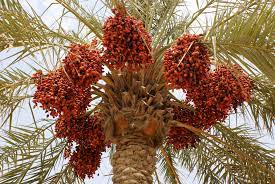
“Tu b’Shvat higi’ah, chag ha’ilanot….” So go the lyrics of the famous children’s song. Tu b’Shvat, the delightful new year of the trees, is when we eat the sheva minim, the special fruits of the Eretz Yisrael. They are wheat, barley, grapes, figs, pomegranates, olives, and dates, which are mentioned in the pasuk (verse) in the order of their ripening.
Besides being delicious, each of the seven species was associated by the mekubalim (kabbalists) with the one of
the seven sefiros. Wheat corresponds
to chesed (kindness), barley to gevurah (strength), grapes to tiferes
(harmony), figs to netzach (perseverance),
pomegranates to hod (humility),
olives to yesod (foundation), and
dates to malchus (royalty). The
kabbalists ate these foods in 16th century Tzfas at a Tu b’Shvat seder, a custom that has had a revival
in our time.
The sheva minim had a prominent place
in the Beis Hamikdash. The kohanim used olive oil to light the menorah.
They used wheat to make the lechem panim. Barley was fed to the animals
designated to be korbonos. And wine from
grapes had many roles to play.
The sheva minim have also inspired
artists since ancient times and appear as a motif on mosaic floors and other
artistic works. I am a Judaica collector (mostly of silver pieces), but I also
have another hobby: I commission artists to hand-paint violins. One of my most
popular violins is the violin of the sheva
minim painted by Chaya Greenwald.
Why the sheva minim on a musical
instrument? In addition to their kabbalistic meanings, these seven species have
many halachos associated with them, including terumah, ma’aser, orlah,kila’im, peah, and shmita. The sheva minim are part of the “music” of tzedaka and bracha that the
agricultural dinim of Eretz Yisrael
teach us. And so, I felt it fitting to display the seven fruits and grains on a
violin.
* *
*
According to a midrash,
“All sevens are beloved.” The number seven is incredibly prominent
throughout the Torah, from the creation of the world in seven days to the
holiday of Shavuot, which comes seven weeks after
Pesach. There are seven
terms for the heavens and seven terms for the earth. Enoch was the seventh
generation from Adam, Moses was the seventh generation from Abraham, and David
was the seventh son in his family.
There are hundreds of other
connections to the number seven, but here are some of the most prominent:
·
The first verse of the Torah has
seven words.
·
Shabbat falls on the seventh day of the week, and every
Shabbos, seven people are called to the Torah.
·
There are seven Noahide laws that
all humanity must follow.
·
Pesach and Sukkos are celebrated for seven
days in Israel.
·
Shemitta occurs every seven years.
·
When an immediate relative dies,
Jews sit shiva (which means seven) for
seven days.
·
Moses was born and died on the seventh
day of Adar.
·
There are seven female prophets
named in the Talmud: Sarah, Miriam, Deborah, Hannah, Abigail, Chuldah, and
Esther.
·
Each of the plagues in Egypt
lasted seven days.
·
The menorah in the Beis Hamikdash had seven branches.
·
The bride circles the groom seven
times under the chuppa.
·
Seven blessings are said under
the chuppa, and there are seven days
of celebration (sheva brachos).
* *
*
The Ramban, in 12th century Spain, explains a beautiful kabbalistic
concept: Seven is the number of the natural world. There are seven days in
the week, seven notes on the musical scale, and seven directions
(left, right, up, down, forward, back and center). Seven represents the natural
world. Of course, we Baltimoreans understand this well as one of America’s
finest kosher markets is called, appropriately, Seven Mile Market!
May all humanity that observe the sheva
mitzvos bnei Noah celebrate the number seven as a hakaras hatov (gratitude) to Hashem, and may that bring the geulah sheleima to our troubled world.






